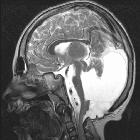Aicardi-Goutières-Syndrom

Aicardi
syndrome • Aicardi syndrome - Ganzer Fall bei Radiopaedia

Coloboma •
Aicardi syndrome - Ganzer Fall bei Radiopaedia

Coloboma •
Aicardi syndrome - Ganzer Fall bei Radiopaedia
Aicardi syndrome is a rare severe developmental disorder. It results from an X-linked genetic defect that is fatal in males and therefore only manifests in females (except for rare 47, XXY cases).
Note: Aicardi syndrome is distinct from Aicardi-Goutieres syndrome although both are named after Jean Aicardi (see below).
Clinical presentation
The typical presentation in infancy is with a triad of:
- infantile spasms: salaam seizures with typical bowing of the head
- corpus callosal dysgenesis: most consistent feature
- distinctive chorioretinal lacunae: pathognomonic
Pathology
Characteristic malformations affect the brain, spine and eyes and include:
- brain
- agenesis of the corpus callosum
- colpocephaly
- grey matter heterotopia
- asymmetry of cerebral hemispheres
- posterior fossa abnormalities (95%), including Dandy-Walker continuum:
- posterior fossa cyst
- cerebellar hypoplasia
- tectal enlargement
- choroid plexus papilloma
- choroid plexus carcinoma
- polymicrogyria (predominantly frontal and perisylvian)
- intracranial cysts (diameters range between 1.0-5.0 cm)
- midline interhemispheric: 81%
- intraventricular: 29%
- parenchymal: 10%
- extra-axial: 8%
- ocular
- microphthalmia
- coloboma
- chorioretinopathy
- eyelid twitching
- absent pupillary reflexes
- funnel-shaped disks
- spine
- scoliosis
- spina bifida
- butterfly or block vertebrae
- hemivertebrae
- abnormal costovertebral articulation
History and etymology
First described in 1961 by Jean Francois Marie Aicardi (1926-2015), a French neuropaediatrician .
Siehe auch:
- Spina bifida
- Blockwirbel
- Skoliose
- Polymikrogyrie
- Heterotopie der grauen Substanz
- Kolpozephalie
- Karzinom des Plexus choroideus
- Plexuspapillom
- Halbwirbel
- Kolobom
- Mikrophthalmus
- Dysgenesie des Corpus callosum
- Dandy Walker continuum
- Balkenmangel
und weiter:

 Assoziationen und Differentialdiagnosen zu Aicardi-Goutières-Syndrom:
Assoziationen und Differentialdiagnosen zu Aicardi-Goutières-Syndrom:












